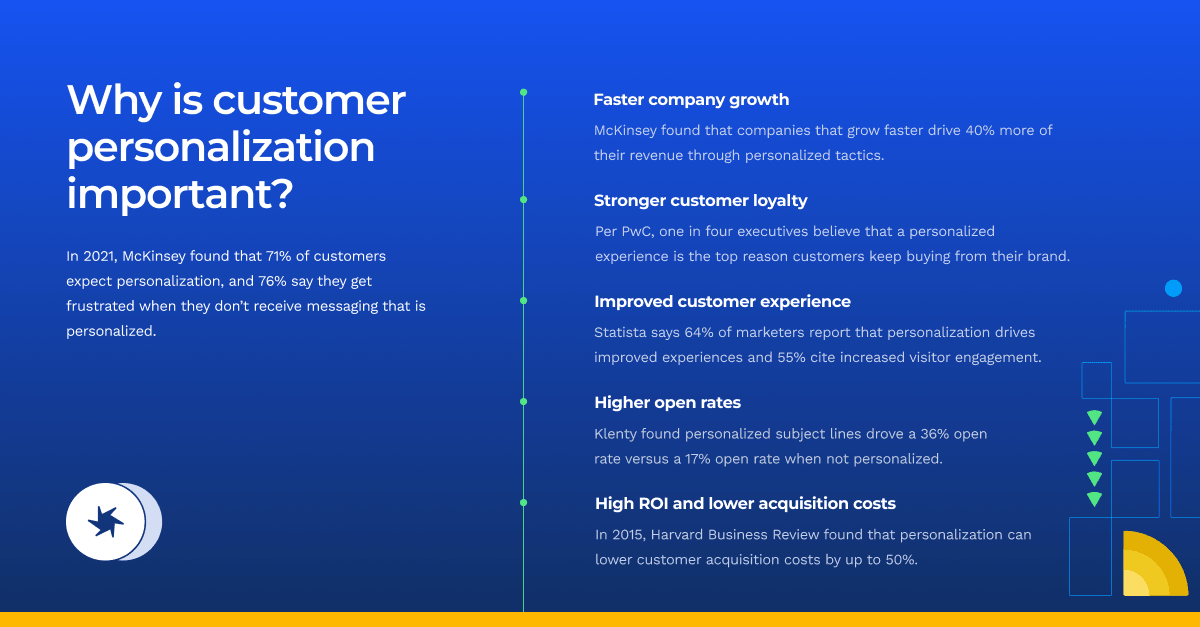Tips for building an effective personalization strategy
The factors used to personalize a campaign vary based on the industry, buyer types (B2B or B2C), length of the buying cycle, preferred marketing channels, and more. Across all of those facets of customer personalization, here are a few fundamental best practices to consider for the best results.
Use A/B testing to improve personalization
As with any campaign, use rigorous testing to learn what kind of messaging and offerings appeal to which subsets of the audience. Test different types of personalization, like abandoned cart emails or recommended add-on text messages, and positioning elements like discounts, loyalty program points, or limited-time messaging.
Pay close attention to click rates and conversion rates to see what works best for audiences overall and individuals, which fuels better-tailored campaigns.
Personalize based on the customer journey
Personalization changes over time — customer personalization should look different early on in someone’s buyer journey from how it looks after they’ve made several purchases. For one thing, brands gain more data about customers over time, which should change how they market to the buyer. Marketing strategies should also evolve based on how customer needs change.
For example, pay attention to buying behaviors. Has a customer slowed their purchasing patterns, or are they especially interested in clearance items? Take these budget-conscious signals into consideration. Look out for behaviors that might signal churn or willingness to spend more money as time goes on, and personalize the message based on these factors.
Take an omnichannel approach
A holistic personalization strategy considers every channel where customers encounter the brand. It collects information from their behavior anywhere and personalizes messaging everywhere. This is an omnichannel approach — one that creates a seamless, integrated approach to customer experience personalization.
Create a consistent experience on every marketing channel by personalizing the message to the individual customer across channels. That way, the audience doesn’t just feel known on the website, but in each place they find the brand and messaging.
Gather customer insights from internal teams
Customer-facing teams like sales and customer service spend much of their time talking to or serving customers. So they’re likely to notice behavior patterns, customer preferences, and missed marketing opportunities for personalization. They know what leads to customer satisfaction and what leads to churn. Spend time talking to these teams or ask them for feedback on new ways to personalize campaigns.
For instance, they might notice that customers who spend above a defined dollar amount buy certain products together or rarely buy another product. If they pass that information to marketing, use that information to shape the content of campaigns and personalize more effectively.
Collect zero and first party data whenever possible
The days of data collection via third-party cookies are numbered. Brands must shift their focus to strategies focused on data that customers offer up freely.
Zero party data (such as data from forms and surveys) and first party data (like product and browsing data) come directly and voluntarily from customers. These data types are more compliant and transparent, so they’ll be a more important part of marketers’ approach to customer personalization. Make a plan to proactively collect customer data and use it to fuel personalization.
Leverage AI to execute personalization at scale
Between data analysis and application, plus the creativity needed for any marketing campaign, true personalization at scale without technology like AI isn’t just time-consuming — it’s virtually impossible. But AI excels at processing large amounts of data quickly, which means marketers can use it to review data to create audiences and journeys to power deeply personalized experiences.
A tool like a natural language audience builder lets marketers describe the audience they’re trying to reach as they would to a colleague. Using data from their cloud, generative AI will determine the relevant data fields and identify individuals who meet the criteria to create the audience so they can personalize campaigns to that exact subset of customers.




